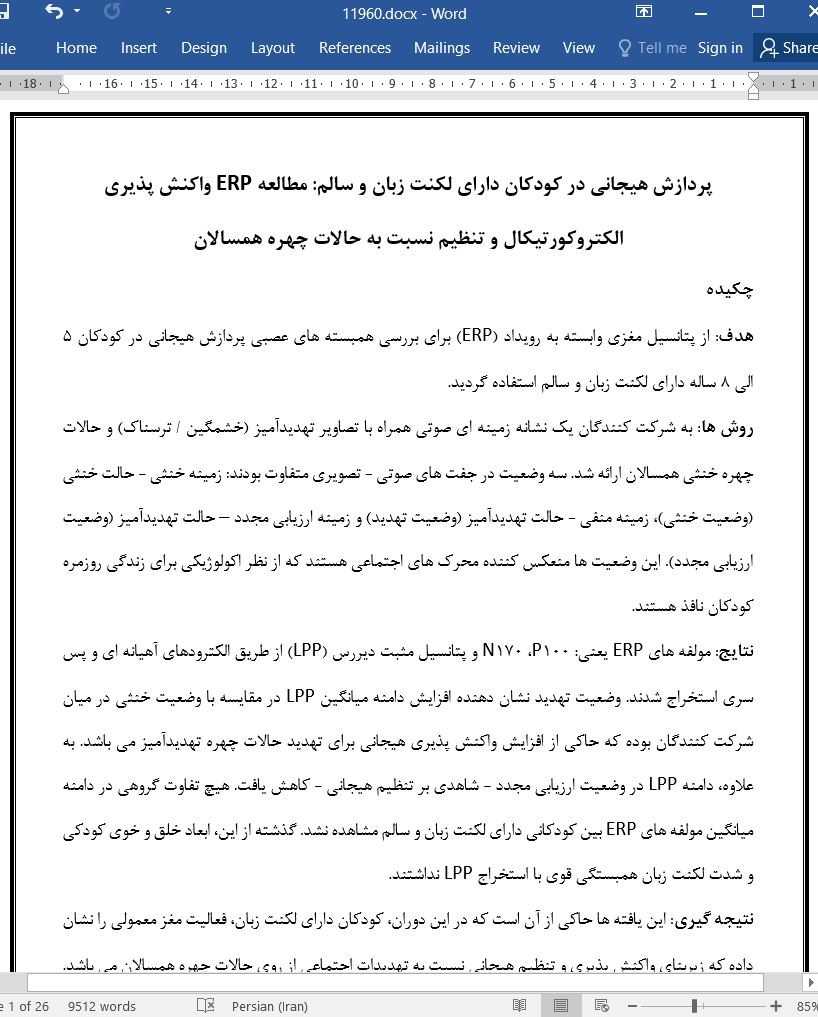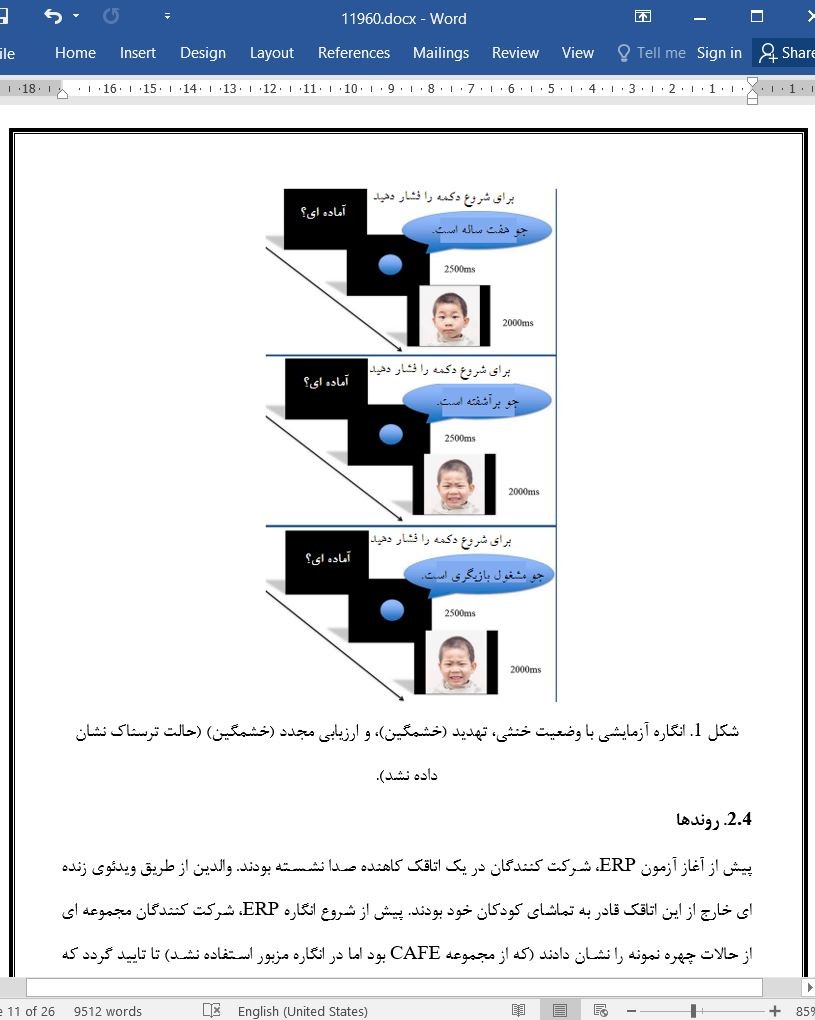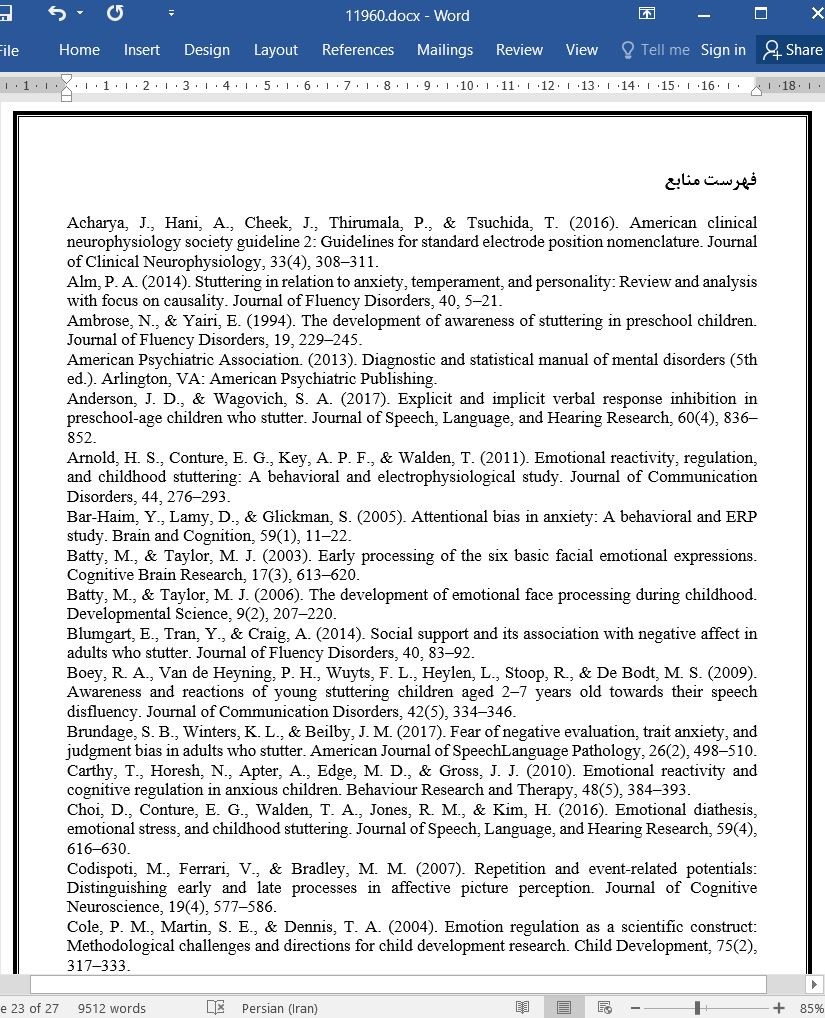
پردازش هیجانی در کودکان دارای لکنت زبان و سالم
چکیده
هدف: از پتانسیل مغزی وابسته به رویداد (ERP) برای بررسی همبسته های عصبی پردازش هیجانی در کودکان ۵ الی ۸ ساله دارای لکنت زبان و سالم استفاده گردید.
روش ها: به شرکت کنندگان یک نشانه زمینه ای صوتی همراه با تصاویر تهدیدآمیز (خشمگین / ترسناک) و حالات چهره خنثی همسالان ارائه شد. سه وضعیت در جفت های صوتی - تصویری متفاوت بودند: زمینه خنثی - حالت خنثی (وضعیت خنثی)، زمینه منفی - حالت تهدیدآمیز (وضعیت تهدید) و زمینه ارزیابی مجدد – حالت تهدیدآمیز (وضعیت ارزیابی مجدد). این وضعیت ها منعکس کننده محرک های اجتماعی هستند که از نظر اکولوژیکی برای زندگی روزمره کودکان نافذ هستند.
نتایج: مولفه های ERP یعنی: ۱۰۰P، ۱۷۰N و پتانسیل مثبت دیررس (LPP) از طریق الکترودهای آهیانه ای و پس سری استخراج شدند. وضعیت تهدید نشان دهنده افزایش دامنه میانگین LPP در مقایسه با وضعیت خنثی در میان شرکت کنندگان بوده که حاکی از افزایش واکنش پذیری هیجانی برای تهدید حالات چهره تهدیدآمیز می باشد. به علاوه، دامنه LPP در وضعیت ارزیابی مجدد - شاهدی بر تنظیم هیجانی - کاهش یافت. هیچ تفاوت گروهی در دامنه میانگین مولفه های ERP بین کودکانی دارای لکنت زبان و سالم مشاهده نشد. گذشته از این، ابعاد خلق و خوی کودکی و شدت لکنت زبان همبستگی قوی با استخراج LPP نداشتند.
نتیجه گیری: این یافته ها حاکی از آن است که در این دوران، کودکان دارای لکنت زبان، فعالیت مغز معمولی را نشان داده که زیربنای واکنش پذیری و تنظیم هیجانی نسبت به تهدیدات اجتماعی از روی حالات چهره همسالان می باشد.
۱. مقدمه
لکنت رشدی که اختلال سیالی کلامی با آغاز کودکی نیز خوانده می شود (DSM-5؛ انجمن روانپزشکی آمریکا، ۲۰۱۳)، یک اختلال رشدی - عصبی است که با ظهور مداوم تولید گفتار غیرفصیح مشخص می شود. پیامدهای روانی - اجتماعی منفی مرتبط با لکنت زبان با شروع اختلال مشاهده شده (آمبروز و یایری، ۱۹۹۴؛ بوی و همکاران، ۲۰۰۹) و لکنت زبان درازمدت با اضطراب شدید و کاهش بهزیستی یا سلامت همراه است (بلومگارت، ترن و کریگ، ۲۰۱۴؛ کریگ و ترن، ۲۰۱۴؛ ایوراش، رپی، وانگ و لاو، ۲۰۱۷). علاوه بر عوامل گفتاری و عوامل حرکتی و زبانی گفتار، نظریه های چندعاملی لکنت زبان به نقش عواطف در سبب شناسی و ماهیت لکنت زبان اذعان می نمایند (کانچر و والدن، 2012؛ اسمیت و وبر، 2017). مشاهده شده است که کودکان دارای لکنت زبان (CWS) سطوح بالایی از فعالیت عصبی خودمختار را در گفتار همراه با لکنت زبان خود در مقایسه با کسانی که با فصاحت صحبت می کنند به نمایش می گذارند (والش و آسلر، ۲۰۱۹). با این حال، انگیختگی و عواطف فیزیولوژیکی همیشه با هم مرتبط نیستند (ماس، ویلهلم و گراس، ۲۰۰۴).
Abstract
Purpose Event-related brain potentials (ERPs) were used to investigate the neural correlates of emotion processing in 5- to 8-year-old children who do and do not stutter.
Methods Participants were presented with an audio contextual cue followed by images of threatening (angry/fearful) and neutral facial expressions from similarly aged peers. Three conditions differed in audio-image pairing: neutral context-neutral expression (neutral condition), negative context-threatening expression (threat condition), and reappraisal context-threatening expression (reappraisal condition). These conditions reflected social stimuli that are ecologically valid to the everyday life of children.
Results P100, N170, and late positive potential (LPP) ERP components were elicited over parietal and occipital electrodes. The threat condition elicited an increased LPP mean amplitude compared to the neutral condition across our participants, suggesting increased emotional reactivity to threatening facial expressions. In addition, LPP amplitude decreased during the reappraisal condition— evidence of emotion regulation. No group differences were observed in the mean amplitude of ERP components between children who do and do not stutter. Furthermore, dimensions of childhood temperament and stuttering severity were not strongly correlated with LPP elicitation.
Conclusion These findings are suggestive that, at this young age, children who stutter exhibit typical brain activation underlying emotional reactivity and regulation to social threat from peer facial expressions.
1. Introduction
Developmental stuttering, also known as Childhood-Onset Fluency Disorder (DSM-5; American Psychiatric Association, 2013), is a neurodevelopmental disorder typified by the persistent manifestation of disfluent speech production. Negative psychosocial consequences associated with stuttering have been observed soon after onset of the disorder (Ambrose & Yairi, 1994; Boey et al., 2009), and long-term stuttering has been associated with excessive anxiety and reduced well-being (Blumgart, Tran, & Craig, 2014; Craig & Tran, 2014; Iverach, Rapee, Wong, & Lowe, 2017). In addition to speech motor and language factors, multifactoral theories of stuttering acknowledge the contribution of emotion to the etiology and nature of stuttering (Conture & Walden, 2012; Smith & Weber, 2017). Children who stutter (CWS) have been observed to exhibit high levels of autonomic nervous activation during their stuttered speech compared to when they speak fluently (Walsh & Usler, 2019). However, physiological arousal and emotion are not always linked (Mauss, Wilhelm, & Gross, 2004).
چکیده
1 مقدمه
1.1 شاخص های ERP واکنش پذیری و تنظیم هیجانی
1.2 هدف مطالعه
2. روش ها
2.1. شرکت کنندگان
2.2. محرک ها
2.3. معیارها
2.4. روندها
2.5. ثبت نوار مغزی
2.6. تجزیه و تحلیل ERP
3. نتایج
3.1. ERP
3.2. اثرات تهدید و ارزیابی مجدد، خلق و خوی کودکی، و شدت لکنت زبان
4. بحث
5. محدودیت ها
6. نتیجه گیری
افشاء مالی
فهرست منابع
Abstract
1. Introduction
1.1. ERP indices of emotional reactivity and regulation
1.2. Purpose of the study
2. Methods
2.1. Participants
2.2. Stimuli
2.3. Measures
2.4. Procedures
2.5. Electroencephalographic recording
2.6. ERP analyses
3. Results
3.1. ERPs
3.2. Threat and reappraisal effects, childhood temperament, and stuttering severity
4. Discussion
5. Limitations
6. Conclusion
Financial disclosure
Acknowledgements
References
- اصل مقاله انگلیسی با فرمت ورد (word) با قابلیت ویرایش
- ترجمه فارسی مقاله با فرمت ورد (word) با قابلیت ویرایش، بدون آرم سایت ای ترجمه
- ترجمه فارسی مقاله با فرمت pdf، بدون آرم سایت ای ترجمه



